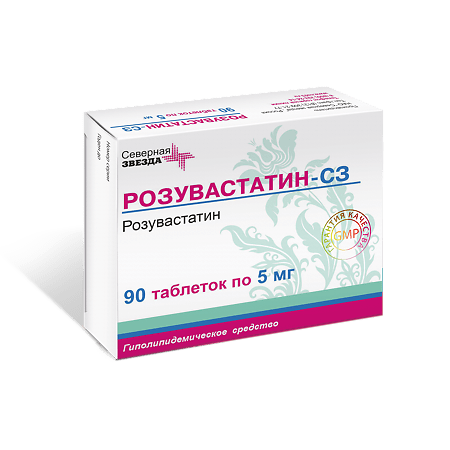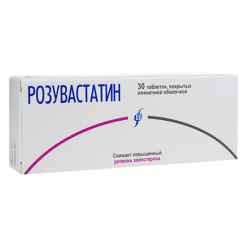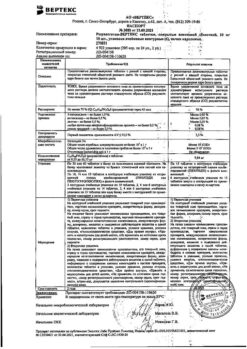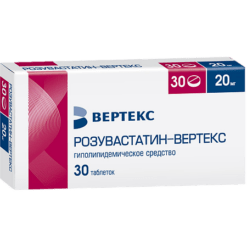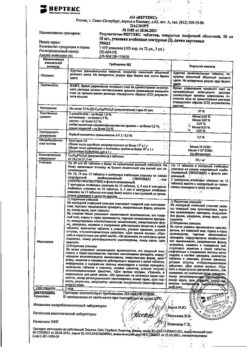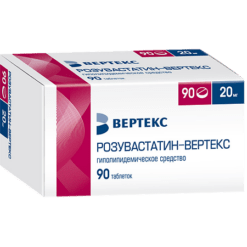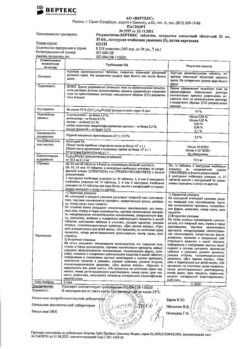No products in the cart.
Rosuvastatin-SZ, 5 mg 90 pcs
€15.60 €13.00
Description
Pharmacotherapeutic drug group:
Hypolipidemic drug – HMG-CoA reductase inhibitor
ATX code: [C10AA07]
Pharmacological Properties
.Pharmacodynamics
Mechanism of action
Rosuvastatin is a selective, competitive inhibitor of HMG-CoA reductase, the enzyme that converts 3-hydroxy-3-methylglutaryl coenzyme A to mevalonic acid, a cholesterol precursor. The main target of rosuvastatin action is the liver, where the synthesis of cholesterol (cholesterol) and catabolism of low-density lipoproteins (LDL) take place.
Rosuvastatin increases the number of “hepatic” LDL receptors on the surface of cells, increasing the capture and catabolism of LDL, which in turn leads to inhibition of synthesis of very low density lipoproteins (VLDL), thereby reducing the total amount of LDL and VLDL.
Pharmacodynamics
Rosuvastatin-CZ reduces elevated concentrations of LDL cholesterol (LDL-C), total cholesterol, triglycerides (TG), increases concentrations of high-density lipoprotein cholesterol (HDL-C) and decreases concentrations of apolipoprotein B (ApoB), non-LDL-C, HDL-C, TG-LDL-C and increases the concentration of apolipoprotein A-I (ApoA-I), reduces the ratio of HDL-C/HC-LDL, total HC/ HC-LDL and HC non-LDL/CC-LDL and the apoB/ApoA-I ratio.
Therapeutic effect is developed within one week after the start of therapy with Rosuvastatin-SZ, after 2 weeks of treatment it reaches 90% of the maximum possible effect. Maximum therapeutic effect is usually reached by the 4th week of therapy and is maintained with regular use of the drug.
Rosuvastatin-SZ is effective in adult patients with hypercholesterolemia with or without hypertriglyceridemia, regardless of race, sex or age, including patients with diabetes and familial hypercholesterolemia.
In 80% of patients with hypercholesterolemia type IIa and IIb according to Fredrickson (mean baseline concentration of LDL-C about 4.8 mmol/l) with the use of the drug in dose of 10 mg LDL-C concentration reaches values less than 3 mmol/l.
In patients with heterozygous familial hypercholesterolemia receiving Rosuvastatin-CS in doses of 20-80 mg, positive dynamics of lipid profile parameters are observed. After titration to a daily dose of 40 mg (12 weeks of therapy), there is a decrease in LDL-C concentration by 53%. In 33% of patients the concentration of LDL-C is less than 3 mmol/l.
In patients with homozygous familial hypercholesterolemia receiving Rosuvastatin-CS in doses of 20 mg and 40 mg the mean decrease of LDL-C concentration is 22%.
In patients with hypertriglyceridemia with initial TG concentrations of 273 to 817 mg/dL who received Rosuvastatin-SZ in doses of 5 mg to 40 mg once daily for 6 weeks, plasma TG concentrations were significantly reduced.
Additive effect is noted in combination with fenofibrate with regard to triglycerides and with nicotinic acid in lipid-lowering doses with regard to HDL-C (see also section “Special indications”).
According to the results of clinical studies, patients with significant hypercholesterolemia and high risk of cardiovascular disease (CVD) should be prescribed a dose of Rosuvastatin-SZ 40 mg.
The results of a clinical trial (Rationale for Statins in Primary Prevention: The Rosuvastatin Interventional Evaluation Study) showed that rosuvastatin significantly reduced the risk of cardiovascular complications.
Pharmacokinetics
Absorption and distribution
. Maximum plasma concentration of rosuvastatin is reached approximately 5 hours after oral administration. Absolute bioavailability is approximately 20%.
Rosuvastatin is metabolized primarily by the liver, which is the main site of cholesterol synthesis and metabolism of LDL-C. The volume of distribution of rosuvastatin is
approximately 134 liters. Approximately 90% of rosuvastatin is bound to plasma proteins, mainly to albumin.
Metabolism
It is subject to limited metabolism (about 10%). Rosuvastatin is a non-core substrate for metabolism by enzymes of cytochrome P450 system. The main isoenzyme involved in metabolism of rosuvastatin is CYP2C9 isoenzyme. CYP2C19, CYPZA4 and CYP2D6 isoenzymes are less involved in metabolism.
The main identified metabolites of rosuvastatin are N-desmethylrosuvastatin and lactone metabolites. N-desmethylrosuvastatin is about 50% less active than rosuvastatin, lactone metabolites are pharmacologically inactive. More than 90% of the pharmacological activity for inhibition of circulating HMG-CoA reductase is provided by rosuvastatin, the rest by its metabolites.
Elimation
About 90% of the dose of rosuvastatin is excreted unchanged through the intestine (including absorbed and unabsorbed rosuvastatin). The remaining part is excreted by the kidneys. Plasma elimination half-life (T1/2) is approximately 19 hours. The elimination half-life does not change with increasing drug dose. Mean geometric plasma clearance is approximately 50 L/hour (coefficient of variation 21.7%). As in the case of other HMG-CoA reductase inhibitors, the membrane cholesterol transporter, which plays an important role in hepatic elimination of rosuvastatin, is involved in the “hepatic” uptake of rosuvastatin.
Linearity
The systemic exposure of rosuvastatin increases in proportion to the dose. Pharmacokinetic parameters do not change with daily administration.
Particular patient populations. Age and sex
Pass and age have no clinically significant effect on the pharmacokinetics of rosuvastatin.
Ethnic groups
. Pharmacokinetic studies have shown an approximately two-fold increase in median AUC (area under the concentration-time curve) and Cmax (maximum plasma concentration) of rosuvastatin in patients of the Mongoloid race (Japanese, Chinese, Filipino, Vietnamese, and Korean) compared with Caucasians; Hindus showed a 1.3-fold increase in median AU and Cmax. Pharmacokinetic analysis showed no clinically significant differences in pharmacokinetics among Caucasians and non-Hispanics.
Renal failure
In patients with mild to moderately severe renal failure the plasma concentration of rosuvastatin or N-desmethylrosuvastatin does not change significantly. In patients with severe renal insufficiency (creatinine clearance (CK) less than 30 ml/min) the plasma concentration of rosuvastatin is 3 times higher, and N-desmethylrosuvastatin concentration is 9 times higher than in healthy volunteers. Plasma concentrations of rosuvastatin were approximately 50% higher in patients on hemodialysis than in healthy volunteers.
Hepatic failure
In patients with various stages of hepatic failure, there was no increase in the half-life of rosuvastatin in patients with a Child-Pugh score of 7 or lower. Two patients with Child-Pugh scores of 8 and 9 showed at least a 2-fold increase in half-life. There is no experience with rosuvastatin in patients with more than a Child-Pugh score of 9.
Genetic polymorphism
. HMG-CoA reductase inhibitors, including rosuvastatin, bind to the transport proteins OATP1B1 (an organic anion transport polypeptide involved in the capture of statins by hepatocytes) and BCRP (efflux transporter). Carriers of SLCO1B1 (OATP1B1) c.521CC and ABCG2 (BCRP) c.421AAA genotypes had 1.6 and 2.4-fold increased exposure (AUC) to rosuvastatin compared with SLCO1B1 c.521TT and ABCG2 c.421CC genotypes, respectively.
Indications
Indications
Primary Fredrickson hypercholesterolemia (type IIa, including familial heterozygous hypercholesterolemia) or mixed hypercholesterolemia (type IIb) as an adjunct to diet when diet and other nonmedicamental treatments (e.g. exercise, weight loss) are not sufficient.
Active ingredient
Active ingredient
Composition
Composition
Dosage 5 mg
Active ingredient: calcium rosuvastatin in terms of rosuvastatin – 5 mg.
Excipients:
core – lactose monohydrate (milk sugar) – 32.9 mg; calcium hydrophosphate dihydrate – 5.0 mg; povidone (polyvinylpyrrolidone medium molecular) – 3.0 mg; Croscarmellose sodium (primellose) – 3.0 mg; sodium stearyl fumarate – 0.8 mg; colloidal silica (aerosil) – 0.3 mg; microcrystalline cellulose – 30.0 mg;
How to take, the dosage
How to take, the dosage
To the mouth, do not chew or crush the tablet, swallow it whole with water. The drug can be taken at any time of the day regardless of meals.
People should start a standard hypocholesterolemic diet before starting therapy with Rosuvastatin-SZ and continue it during treatment. The dose of the drug should be adjusted individually depending on the goals of therapy and the therapeutic response to treatment, taking into account current recommendations for target lipid concentrations.
The recommended starting dose for patients starting therapy or switching from other HMG-CoA reductase inhibitors should be 5 mg or 10 mg of Rosuvastatin-CZ once daily. When choosing the initial dose, the individual cholesterol content should be guided and the possible risk of cardiovascular complications should be taken into account, as well as the potential risk of side effects should be assessed. If necessary, the dose may be
increased to a higher dose after 4 weeks (see section “Pharmacodynamics”).
Because of the possible development of side effects when taking a dose of 40 mg, compared to lower doses of the drug (see section “Side Effects”).
Particularly in patients with severe hypercholesterolemia and high risk of cardiovascular complications (especially in patients with familial hypercholesterolemia), in whom the desired therapy result was not achieved with the 20 mg dose, and who will be monitored by a specialist (see section “Special considerations”), an increase in dose to 40 mg, after additional dosing above the recommended initial dose for 4 weeks of therapy, may only be undertaken.) We recommend especially close monitoring of patients receiving the drug at a dose of 40 mg.
The 40 mg dose is not recommended for patients who have not previously seen a physician. After 2-4 weeks of therapy and/or when increasing the dose of Rosuvastatin-SZ, monitoring of lipid metabolism is necessary (if necessary, a dose adjustment is required).
Elderly patients
Dose adjustment is not required.
Patients with renal impairment
Dose adjustment is not required in patients with mild to moderate renal impairment. In patients with severe renal failure (CKD less than 30 ml/min) the use of Rosuvastatin-SZ is contraindicated. The use of the drug in dose of 40 mg is contraindicated in patients with moderate renal impairment (CK 30-60 ml/min) (see sections “Special Indications” and “Pharmacodynamics”).
In patients with moderate renal dysfunction, a starting dose of 5 mg is recommended.
Patients with hepatic impairment
Rosuvastatin-CS is contraindicated in patients with active liver disease (see section “Contraindications”).
Special populations. Ethnic groups
When studying pharmacokinetic parameters of rosuvastatin in patients belonging to different ethnic groups, an increase in systemic concentration of rosuvastatin was noted among Japanese and Chinese (see section “Special indications”).
This fact should be considered when prescribing Rosuvastatin-SZ to these groups of patients. When prescribing doses of 10 mg and 20 mg, the recommended starting dose for mongoloid patients is 5 mg. A dose of 40 mg is contraindicated in patients of mongoloid race (see Contraindications).
Genetic polymorphisms
Carriers of SLCO1B1 (OATP1B1) c.521CC and ABCG2 (BCRR) c.421AA had increased exposure (AUC) to rosuvastatin compared with SLCO1B1 c.521TT and ABCG2 c.421CC genotype carriers. For c.521CC or c.421AA genotype carriers, the recommended maximum dose of Rosuvastatin-CZ is 20 mg once daily (see sections “Pharmacokinetics” and “Precautions” and “Interaction with Other Medicinal Products”).
Patients susceptible to myopathy
The drug is contraindicated in a dose of 40 mg in patients with factors that may indicate a predisposition to myopathy (see Contraindications). When doses of 10 mg and 20 mg are prescribed, the recommended starting dose for this group of patients is 5 mg (see Contraindications).
Companion therapy
Rosuvastatin binds to various transport proteins (in particular to OATP1B1 and VSRP). When co-administration of Rosuvastatin-CZ with drugs (such as cyclosporine, some HIV protease inhibitors, including the combination of ritonavir with atazanavir, lopinavir and/or tipranavir) that increase the plasma concentration of rosuvastatin due to interaction with transport proteins, the risk of myopathy (including rhabdomyolysis) may increase (see sections “Cautions” and “Interaction with other medicinal products”). In such cases, the possibility of prescribing alternative therapy or temporary discontinuation of Rosuvastatin-CZ should be assessed. If the use of the above drugs is necessary, the benefit-risk ratio of concomitant therapy with Rosuvastatin-SZ should be assessed and the possibility of reducing its dose should be considered (see section “Interaction with other medicinal products”).
Interaction
Interaction
Influence of other drugs on rosuvastatin
Inhibitors of transport proteins:
Rosuvastatin binds to some transport proteins, particularly OATP1B1 and BCRP. Concomitant use of drugs that are inhibitors of these transport proteins may be accompanied by increased plasma concentrations of rosuvastatin and an increased risk of myopathy (see Table 1 and sections “Administration and Doses” and “Cautionary Note”).
Cyclosporine: Concomitant use of rosuvastatin and cyclosporine had an average AUC of 7 times higher than that observed in healthy volunteers (see Table 1). No effect on the plasma concentration of cyclosporine. Rosuvastatin-CZ is contraindicated in patients taking cyclosporine (see section “Contraindications”).
Human immunodeficiency virus (HIV) protease inhibitors:
While the exact mechanism of interaction is unknown, co-administration of HIV protease inhibitors may result in a significant increase in rosuvastatin exposure (see Table 1). A pharmacokinetic study of concomitant administration of 20 mg rosuvastatin with a combination drug containing two HIV protease inhibitors (400 mg lopinavir/100 mg ritonavir) in healthy volunteers resulted in approximately twofold and fivefold increases in AUC(0-24) and Cmax of rosuvastatin, respectively. Therefore, concomitant administration of rosuvastatin and HIV protease inhibitors is not recommended (see sections “Dosage and administration”, “Contraindications” and “Special indications”, Table 1).
Hemfibrozil and other hypolipidemic agents: The co-administration of rosuvastatin and gemfibrozil results in a 2-fold increase in the maximum plasma concentration of rosuvastatin and the AUC of rosuvastatin (see “Special Indications”). Based on the data on specific interactions, no pharmacokinetic interaction with fenofibrate is expected, pharmacodynamic interaction is possible.
Hemfibrozil, fenofibrate, other fibrates and lipid-lowering doses of nicotinic acid increased the risk of myopathy when used concomitantly with HMG-CoA reductase inhibitors, possibly due to the fact that they may cause myopathy when used in monotherapy (see section “Special Instructions”). In concomitant use of the drug with gemfibrozil, fibrates, nicotinic acid in lipid-lowering doses (more than 1 g/day) patients are recommended to take an initial dose of the drug of 5 mg, taking a dose of 40 mg is contraindicated in concomitant administration with fibrates (see sections “Contraindications”, “Dosage and administration”, “Special indications”).
Ezetimibe: Concomitant administration of Rosuvastatin-SZ at dose 10 mg and ezetimibe at dose 10 mg was associated with increased AUC of rosuvastatin in patients with hypercholesterolemia (see Table 1). An increased risk of adverse events due to pharmacodynamic interaction between rosuvastatin-CZ and ezetimibe cannot be excluded.
Antacids: Simultaneous use of rosuvastatin and suspensions of antacids containing aluminum and magnesium hydroxide leads to a decrease in plasma concentration of rosuvastatin by approximately 50%. This effect is weaker if antacids are used 2 hours after rosuvastatin administration. The clinical significance of this interaction has not been studied.
Eritromycin: Simultaneous use of rosuvastatin and erythromycin decreases AUC of rosuvastatin by 20% and Cmax of rosuvastatin by 30%. This interaction may occur as a result of increased intestinal motility caused by taking erythromycin.
Cytochrome P450 isoenzymes: The results of in vivo and in vitro studies showed that rosuvastatin is neither an inhibitor nor an inducer of cytochrome P450 isoenzymes. In addition, rosuvastatin is a weak substrate for these isoenzymes. Therefore, no interaction of rosuvastatin with other drugs at the level of metabolism involving cytochrome P450 isoenzymes is expected. No clinically significant interaction of rosuvastatin with fluconazole (inhibitor of CYP2C9 and CYPCA4 isoenzymes) and ketoconazole (inhibitor of CYP2A6 and CYPCA4 isoenzymes) was observed.
Drug interactions that require dose adjustment of rosuvastatin (see. Table 1)
The dose of Rosuvastatin-SZ should be adjusted if it is necessary to combine it with drugs that increase exposure to rosuvastatin. If an increase in exposure is expected by a factor of 2 or more, the initial dose of Rosuvastatin-SZ should be 5 mg once daily. The maximum daily dose of Rosuvastatin-SZ should also be adjusted so that the expected exposure to rosuvastatin does not exceed that of the 40 mg dose taken without concomitant administration of drugs that interact with rosuvastatin. For example, maximal daily dose of drug Rosuvastatin-SZ in concomitant use with gemfibrozil is 20 mg (1.9-fold increase of exposure), with ritonavir/atazanavir – 10 mg (3.1-fold increase of exposure).
Table 1.
The effect of concomitant therapy on exposure to rosuvastatin (AUC., data are given in descending order) – results of published clinical trials
Regimen of concomitant therapy
Regimen of rosuvastatin
AUCChange AUC of rosuvastatin
Cyclosporine 75-200 mg
2 times a day., 6 months.
10 mg once daily, 10 days
7.1-fold increase
Atazanavir 300 mg/ritonavir 100 mg
once daily., 8 days
10 mg once
3.1-fold increase
Lopinavir 400 mg/ritonavir 100 mg
2 times daily., 17 days
20 mg once daily, 7 days
2.1-fold increase
Hemfibrozil 600 mg
2 times daily., 7 days
80 mg once
Increased 1.9 times
Eltrombopag 75 mg
once daily., 10 days
10 mg once
1.6-fold increase
Darunavir 600 mg/ritonavir 100 mg
2 times daily., 7 days
10 mg once daily, 7 days
1.5-fold increase
Tipranavir 500 mg/ritonavir 200 mg
2 times daily., 11 days
10 mg once
Increased 1.4 times
Dronedarone 400 mg 2 times a day.
No data
1.4-fold increase
Itraconazole 200 mg
once daily., 5 days
10 mg or 80 mg once
Increased 1.4 times
Ezetimibe 10 mg
once daily., 14 days
10 mg
once daily, 14 days
1.2-fold increase
Fosamprenavir 700 mg/
ritonavir 100 mg
2 times daily., 8 days
10 mg once
No change
Aleglitazar 0.3 mg, 7 days
/p>
40 mg, 7 days
No change
Silymarin 140 mg
3 times a day., 5 days
10 mg once
No change
Phenofibrate 67 mg
3 times daily., 7 days
10 mg, 7 days
No change
Rifampin 450 mg
1 time per day., 7 days
20 mg once
No change
Ketoconazole 200 mg
2 times a day., 7 days
80 mg once
No change
Fluconazole 200 mg
once daily., 11 days
80 mg once
No change
Erythromycin 500 mg
4 times a day., 7 days
80 mg once
28% reduction
Baicalin 50 mg
3 times daily., 14 days
20 mg once
/td>
47% reduction
Special Instructions
Special Instructions
Renal effects
Patients receiving high doses of Rosuvastatin-CZ (mainly 40 mg) have had tubular proteinuria, which in most cases was transient. This proteinuria was not indicative of acute kidney disease or progression of renal disease. In patients taking the drug at a dose of 40 mg, it is recommended to monitor renal function parameters during treatment.
Motor system
The following musculoskeletal effects have been reported with Rosuvastatin-CZ at all doses and, in particular, with doses greater than 20 mg: Myalgia, myopathy, and, rarely, rhabdomyolysis.
Creatine phosphokinase determination
The determination of CPK activity should not be performed after intense physical activity or in the presence of other possible causes of increase in CPK activity, which may lead to misinterpretation of the results. If the initial CPK activity is significantly elevated (5 times higher than the upper limit of normal) the measurement should be repeated in 5-7 days. The therapy should not be started if the repeated test confirms the initial CPK activity (more than 5 times higher than the upper limit of normal).
Before therapy
. As with other HMG-CoA reductase inhibitors, caution should be exercised when prescribing Rosuvastatin-CZ as well as when prescribing other HMG-CoA reductase inhibitors in patients with myopathy/rhabdomyolysis risk factors (see
Precaution. section “Caution”), the risk/benefit ratio of therapy should be considered and clinical monitoring should be performed.
At the time of therapy
The patient should be informed of the need to immediately inform the physician if muscle pain, muscle weakness, or spasms occur unexpectedly, especially in conjunction with malaise and fever. In such patients, CPK activity should be determined. Therapy should be stopped if CPK activity is significantly elevated (more than 5 times the upper limit of normal) or if muscle symptoms are severe and cause daily discomfort (even if CPK activity is 5 times less than the upper limit of normal). If symptoms disappear and CPK activity returns to normal, consideration should be given to re-prescribing Rosuvastatin-CZ or other HMG-CoA reductase inhibitors at lower doses with close monitoring of the patient.
Routine monitoring of CPK activity in the absence of symptoms is unnecessary.
There have been very rare cases of immune-mediated necrotizing myopathy with clinical manifestations of persistent proximal muscle weakness and elevated serum CPK levels during treatment or upon discontinuation of statins, including rosuvastatin. Additional muscular and nervous system studies, serologic studies, and therapy with immunosuppressive agents may be required.
There have been no indications of increased skeletal muscle effects when taking Rosuvastatin-SZ and concomitant therapy. However, an increase in myositis and myopathy has been reported in patients taking other HMG-CoA reductase inhibitors in combination with fibrin acid derivatives, including gemfibrozil, cyclosporine, nicotinic acid, azole antifungals, protease inhibitors and macrolide antibiotics. Gemfibrozil increases the risk of myopathy when coadministered with some HMG-CoA reductase inhibitors. Thus, concomitant use of Rosuvastatin-CZ and gemfibrozil is not recommended. It should be carefully weighed the ratio of risk to possible benefit when concomitant use of Rosuvastatin-CZ and fibrates or lipid-lowering doses of nicotinic acid. The use of Rosuvastatin-SZ at a dose of 40 mg together with fibrates is contraindicated (see sections “Interaction with other medicinal products” and “Contraindications”).
Lipid metabolism should be monitored 2-4 weeks after initiating treatment and/or when increasing the dose of Rosuvastatin-SZ (if necessary, a dose adjustment is required).
Liver
Liver function tests are recommended before and 3 months after initiation of therapy. Rosuvastatin-CS should be discontinued or the dose should be reduced if serum transaminase activity exceeds 3 times the upper limit of normal.
In patients with hypercholesterolemia due to hypothyroidism or nephrotic syndrome, therapy for underlying diseases should be performed before starting treatment with Rosuvastatin-SZ.
Special populations. Ethnic groups
In pharmacokinetic studies in Chinese and Japanese patients, increased systemic rosuvastatin concentrations have been observed compared to those obtained in Caucasoid patients (see sections “Administration and Doses” and “Pharmacokinetics”).
HIV protease inhibitors
The combined use of the drug with HIV protease inhibitors is not recommended (see sections “Interaction with other medicinal products” and “Contraindications”).
Lactose
The drug should not be used in patients with lactase deficiency, galactose intolerance and glucose-galactose malabsorption.
Interstitial lung disease
Single cases of interstitial lung disease have been reported with some statins, especially for long periods of time. Manifestations of the disease may include dyspnea, non-productive cough, and deterioration in general well-being (weakness, weight loss, and fever). If interstitial lung disease is suspected, statin therapy should be discontinued.
Type 2 diabetes mellitus
In patients with glucose concentrations between 5.6 and 6.9 mmol/L, therapy with Rosuvastatin-CS has been associated with an increased risk of developing type 2 diabetes mellitus.
Effects on the ability to drive and operate machinery
There have been no studies of the effect of Rosuvastatin-CS on the ability to drive and operate machinery. Caution should be exercised when driving motor transport or working that requires increased concentration and rapid psychomotor reactions (dizziness may occur during therapy).
Synopsis
Synopsis
Contraindications
Contraindications
For the drug Rosuvastatin-SZ in daily doses of 5 mg, 10 mg and 20 mg:
– hypersensitivity to rosuvastatin or any of the drug components
– lactose intolerance, lactase deficiency or glucose-galactose malabsorption (the drug contains lactose)
– childhood age below 18 years
– Active liver disease, including steady increase of serum transaminase activity and any increase of transaminase activity in the blood serum (more than 3 times higher than the upper limit of normal values)
– severe renal insufficiency (CKR less than 30 ml/min).)
– myopathy
– concomitant use of cyclosporine
– in women: pregnancy; breastfeeding, absence of adequate contraceptive methods
– increase of creatine phosphokinase (CPK) concentration in blood more than 5 times compared to the upper limit of normal
– concomitant use with HIV-protease inhibitors
– in patients susceptible to the development of myotoxic complications
WARNING
For the drug Rosuvastatin-CS at a daily dose of 5 mg, 10 mg and 20 mg:
Presence of risk of myopathy/rhabdomyolysis – renal failure, hypothyroidism, personal or family history of hereditary muscle disease and prior history of muscle toxicity with other HMG-CoA reductase inhibitors or fibrates; excessive alcohol consumption; age over 65 years; conditions with increased plasma concentrations of rosuvastatin; race (Mongoloid race); concomitant administration with fibrates (see
Concomitant use with colchicine and with ezetimibe (see section “Interaction with other medicinal products”).
Side effects
Side effects
Side effects observed when taking Rosuvastatin-CZ are usually mild and go away on their own. As with other HMG-CoA reductase inhibitors, the incidence of side effects is mostly dose-dependent.
The incidence of adverse effects is as follows: Frequent
(> 1/100, < 1/10); infrequent (> 1/1000, < 1/100); rare (> 1/10000, < 1/1000); very rare (< 1/10000), unspecified frequency (cannot be calculated from available data).
Immune system
Rarely: sensitivity reactions, including angioedema.
Endocrine system
Frequently: Sugar diabetes type 2
Central nervous system
Frequently: headache, dizziness
Digestive tract
Frequently: constipation, nausea, abdominal pain
Rarely: pancreatitis
Skin side
Infrequent: skin itching, rash, urticaria
Motor system side
Frequently: myalgia
Rarely: myopathy (including myositis), rhabdomyolysis
Other
Often: asthenic syndrome
Uses of the urinary system
Patients receiving Rosuvastatin-CS may show proteinuria. Changes in the amount of protein in the urine (from no or trace amounts to ++ or greater) are seen in less than 1% of patients receiving 10 to 20 mg of the drug and in approximately 3% of patients receiving 40 mg of the drug. Little change in urinary protein has been observed with the 20 mg dose. In most cases, proteinuria decreases or disappears during therapy and does not indicate the onset of acute or progression of existing renal disease.
Musculoskeletal disorders
. The following musculoskeletal effects have been reported with Rosuvastatin-CS at all doses and especially with doses greater than 20 mg: Myalgia, myopathy (including myositis), in rare cases, rhabdomyolysis with or without acute renal failure.
Dose-dependent increase in creatine phosphokinase (CPK) activity has been observed in a small number of patients taking rosuvastatin. In most cases it was insignificant, asymptomatic and temporary. In case of increased CPK activity (more than 5 times the upper limit of normal), therapy should be suspended (see section “Special Precautions”).
Hepatic disorders
When using rosuvastatin there is a dose-dependent increase in hepatic transaminase activity in a small number of patients. In most cases it is mild, asymptomatic and temporary.
Laboratory parameters
The following changes in laboratory parameters have also been observed with Rosuvastatin-CS: Increased concentration of glucose, bilirubin, activity of gamma-glutamyl transpeptidase, alkaline phosphatase, thyroid dysfunction.
Postmarketing use
The following side effects have been reported in the postmarketing use of Rosuvastatin-SZ:
Hematopoietic system side effects
Unspecified frequency: Thrombocytopenia
Gastrointestinal tract disorders
Very rare: jaundice, hepatitis
Rarely: increased activity of “liver” transaminases
Unspecified frequency: Diarrhea
Musculoskeletal side
Very rare: arthralgia
Unspecified frequency: Immune-mediated necrotizing myopathy
From the central nervous system
Very rare: polyneuropathy, memory loss
Breathing system
Unspecified frequency: cough, shortness of breath
Remorbidities of the urinary system
Very rare: Hematuria
Sides of the skin and subcutaneous fat
Unspecified frequency: Stevens-Johnson syndrome
Reproductive system and breast
Unspecified frequency: Gynecomastia
Other
Unspecified frequency: peripheral edema.
The following side effects have been reported with some statins: depression, sleep disturbances, including insomnia and “nightmares,” sexual dysfunction.
Ione cases of interstitial lung disease have been reported, especially with long-term use of the drugs (see section “Special Precautions”).
Overdose
Overdose
Pregnancy use
Pregnancy use
Rosuvastatin-SZ is contraindicated in pregnancy and during breastfeeding.
Women of reproductive age should use adequate methods of contraception.
Because cholesterol and other products of cholesterol biosynthesis are important for fetal development, the potential risk of HMG-CoA reductase inhibition exceeds the benefit of using the drug in pregnant women.
If pregnancy occurs during therapy, the drug should be discontinued immediately.
There are no data on excretion of rosuvastatin with the breast milk; therefore, during breast-feeding the drug should be discontinued (see section “Contraindications”).
Similarities
Similarities
Additional information
| Weight | 0.135 kg |
|---|---|
| Shelf life | 3 years. Do not use after the expiration date printed on the package. |
| Conditions of storage | In the dark place at the temperature not more than 25 °С. Keep out of reach of children. |
| Manufacturer | North Star NAO, Russia |
| Medication form | pills |
| Brand | North Star NAO |
Other forms…
Related products
Buy Rosuvastatin-SZ, 5 mg 90 pcs with delivery to USA, UK, Europe and over 120 other countries.

